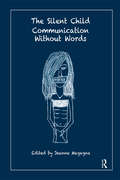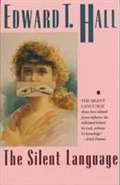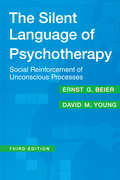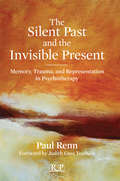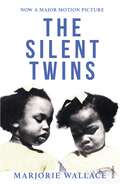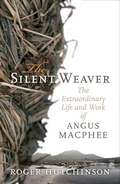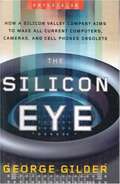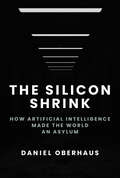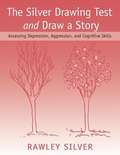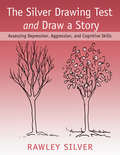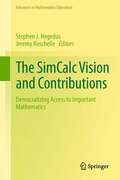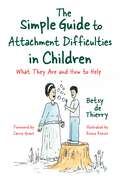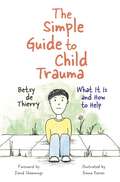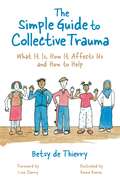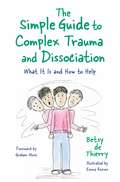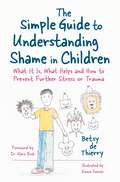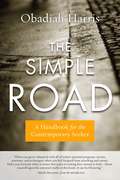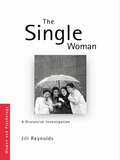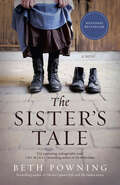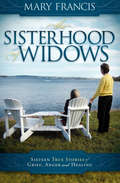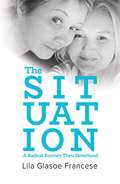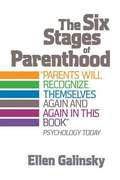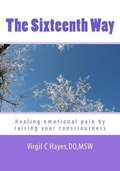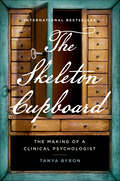- Table View
- List View
The Silent Child: Communication without Words
by Jeanne MagagnaThis book arose out of the need to work with emotionally regressed non-talking children who entered hospital in full retreat from the external world. It helps parents and professionals compassionately comprehend the child's difficulties in depending on someone to receive communication.
The Silent Language
by Edward T. HallIn the everyday, but unspoken give-and-take of human relationships, the "silent language" plays a vitally important role. Here, a leading American anthropologist has analyzed the many ways in which people "talk" to one another without the use of words. The pecking order in a chicken yard, the fierce competition in a school playground, every unwitting gesture and action--this is the vocabulary of the "silent language. " According to Dr. Hall, the concepts of space and time are tools with which all human beings may transmit messages. Space, for example, is the outgrowth of an animal's instinctive defense of his lair and is reflected in human society by the office worker's jealous defense of his desk, or the guarded, walled patio of a Latin-American home. Similarly, the concept of time, varying from Western precision to Easter vagueness, is revealed by the businessman who pointedly keeps a client waiting, or the South Pacific islander who murders his neighbor for an injustice suffered twenty years ago. THE SILENT LANGUAGE shows how cultural factors influence the individual behind his back, wihtout his knowledge.
The Silent Language of Psychotherapy: Social Reinforcement of Unconscious Processes
by David M. YoungTherapeutic changes occur in many places, and among animals as well as humans. A theory that attempts to explain therapeutic changes should be based on principles that apply not only to those changes occurring during the hour, but also to those observed in the educational process, in interpersonal relations, and in the social milieu, as well as with animals. It would be desirable to discover principles broad enough to provide a deeper understanding of therapeutic change in this wide variety of situations.Experienced therapists appear to be similar in what they are doing, although they may disagree as to why they do it. In spite of the arguments about theoretical formulations, it can be observed that during an hour with a patient many psychotherapists may not follow their own theories too well. There probably is some relevance in a comparison of psychotherapy with a concept formation test: the subject gives the correct answers but is unable to state why he did so or what principles he followed in making his choices. The therapist, too, may help a patient but he is often uncertain as to "why" and "how." It is very likely that the effective principles in therapeutic work rest on processes that are more general than the specific principles advanced by different schools.This volume combines the elements of psychodynamic and cognitive behavioral therapy in a theoretical system that focuses on the importance of patient-therapist interaction, especially in terms of the exchange of subtle or covert communication cues. In this significantly updated and expanded edition of their classic text, Beier and Young analyze recent developments in new areas of practice facing today's therapist: managed care and the clinical impact of the control of healthcare delivery; and biological intervention and other issues related to psychotropic medication.
The Silent Past and the Invisible Present: Memory, Trauma, and Representation in Psychotherapy (Relational Perspectives Book Series)
by Paul RennDrawing on research in the fields of cognitive and developmental psychology, attachment, trauma, and neuroscience, as well as 20 years in forensic and private practice, Paul Renn deftly illustrates the ways in which this research may be used to inform an integrated empirical/hermeneutic model of clinical practice. He suggests that silent, invisible processes derived from the past maintain non-optimal ways of experiencing and relating in the present, and that a neuroscience understanding of the dynamic nature of memories, and of the way in which the implicit and explicit memory systems operate and interact, is salient to a concomitant understanding of trauma, personality development, and therapeutic action. Specifically, Renn argues that an intersubjective psychodynamic model can use the power of an emotionally meaningful therapeutic relationship to gradually facilitate both relational and neurological changes in patients with trauma histories. Taken as a whole, these themes reflect a paradigmatic shift in psychoanalytic thinking about clinical work and the process of change.
The Silent Twins: Now a major motion picture starring Letitia Wright
by Marjorie WallaceThe astounding true story behind the major new motion picture starring Letitia Wright and Tamara Lawrance, with a new epilogue from the author'A compelling and tragic story' Mail on Sunday When identical twins, June and Jennifer Gibbons were three they began to reject communication with anyone but each other, and so began a childhood bound together in a strange and secret world. As they grew up, love and hate united to push them to the extreme margins of society and, following a five week spree of vandalism and arson, the silent twins were sentenced to a gruelling twelve-year detention in Broadmoor.Award-winning investigative journalist Marjorie Wallace delves into the twins' silent world, revealing their genius, alienation and the mystic bond by which the extremes of good and evil ended in possession and death.'Breathtaking' Independent 'Extraordinary' Oliver Sacks, New York Times Review of Books
The Silent Weaver: The Extraordinary Life and Work of Angus MacPhee
by Roger HutchinsonA &“fascinating, poignant&” biography of the WWII veteran who, while confined to an asylum, became one of the great outsider artists of modern times (The Scotsman). In September 1939, groups of horsemen in battledress cantered down a broad, grassy plain on the western edge of Europe. The young men of the Western Isles of Scotland were going to war again. They included a tall, shy twenty-four-year-old named Angus MacPhee. Angus returned from war alive but in chronic mental pain, and was referred to the asylum in Inverness, where he spent the next fifty years of his life. During his time at Craig Dunain Hospital, he retreated into his own silent world, and did not speak again until shortly before his death. But &“the quiet big man,&” as he was known, spent his time creating a huge number of objects out of woven grass, sheep&’s wool, and beach leaves—mostly clothes, caps, and hats—which he then let decay or deliberately burned. Only after an art therapist discovered his miraculous creations were some of them preserved for posterity. And only then did Angus MacPhee come home to South Uist, where he died a year later. The Silent Weaver is a rich, moving and enthralling exploration of mental health, the creative process, human frailty, and ancient traditions.
The Silicon Eye: How A Silicon Valley Company Aims to Make All Current Computers, Cameras and Cell Phones Obsolete
by George GilderThe Silicon Eye is a narrative of some of the smartest - and most colorful - people on earth and their race to transform an entire industry.
The Silicon Shrink: How Artificial Intelligence Made the World an Asylum
by Daniel OberhausWhy the race to apply AI in psychiatry is so dangerous, and how to understand the new tech-driven psychiatric paradigm.AI psychiatrists promise to detect mental disorders with superhuman accuracy, provide affordable therapy for those who can’t afford or can’t access treatment, and even invent new psychiatric drugs. But the hype obscures an unnerving reality. In The Silicon Shrink, Daniel Oberhaus tells the inside story of how the quest to use AI in psychiatry has created the conditions to turn the world into an asylum. Most of these systems, he writes, have vanishingly little evidence that they improve patient outcomes, but the risks they pose have less to do with technological shortcomings than the application of deeply flawed psychiatric models of mental disorder at unprecedented scale. Oberhaus became interested in the subject of mental health after tragically losing his sister to suicide. In the book, he argues that these new, ostensibly therapeutic technologies already pose significant risks to vulnerable people, and they won’t stop there. These new breeds of AI systems are creating a psychiatric surveillance economy in which the emotions, behavior, and cognition of everyday people are subtly manipulated by psychologically savvy algorithms that have escaped the clinic. Oberhaus also introduces readers to the concept of “swipe psychology,” which is quickly establishing itself as the dominant mode of diagnosing and treating mental disorders. It is not too late to change course, but to do so means we must reckon with the nature of mental illness, the limits of technology, and what it means to be human.
The Silver Drawing Test & Draw a Story: Assessing Depression, Aggression, and Cognitive Skills
by Rawley SilverIn The Silver Drawing Test and Draw a Story, Rawley Silver draws on her years of experience using therapeutic art with hearing-impaired children, stroke patients, and others with learning disabilities or emotional disturbances.
The Silver Drawing Test and Draw a Story: Assessing Depression, Aggression, and Cognitive Skills
by Rawley SilverArt can be an invaluable means of communication. It can bypass language and impairment and allow for the expression of thoughts or feelings too difficult to communicate with words. In The Silver Drawing Test and Draw a Story, Rawley Silver draws on her years of experience using therapeutic art with hearing-impaired children, stroke patients, and others with learning disabilities or emotional disturbances. The book’s original art assessments use stimulus drawings to elicit responses that provide access to a patient’s emotions and attitudes toward themselves and others, while also testing for the ability to solve problems and convey ideas. Offering tools to assess cognitive skills that often escape detection on verbal tests of intelligence or achievement, the book helps in identifying those at risk for violent behavior or masked depression. Thoroughly updated from Silver’s earlier works, this new book includes techniques to assess aggression and depression that may lead to violence in schools and suicide among children and adolescents. It also addresses important gender and age differences, incorporating new information and updated studies, and it offers an in-depth look at the developmental procedures involved in these art assessments. As education for mental health professionals now includes art therapy more regularly, Silver has provided an invaluable resource for assessing emotional and cognitive content.
The SimCalc Vision and Contributions
by Jeremy Roschelle Stephen J. HegedusThis volume provides essential guidance for transforming mathematics learning in schools through the use of innovative technology, pedagogy, and curriculum. It presents clear, rigorous evidence of the impact technology can have in improving students learning of important yet complex mathematical concepts -- and goes beyond a focus on technology alone to clearly explain how teacher professional development, pedagogy, curriculum, and student participation and identity each play an essential role in transforming mathematics classrooms with technology. Further, evidence of effectiveness is complemented by insightful case studies of how key factors lead to enhancing learning, including the contributions of design research, classroom discourse, and meaningful assessment. The volume organizes over 15 years of sustained research by multiple investigators in different states and countries who together developed an approach called "SimCalc" that radically transforms how Algebra and Calculus are taught. The SimCalc program engages students around simulated motions, such as races on a soccer field, and builds understanding using visual representations such as graphs, and familiar representations such as stories to help students to develop meaning for more abstract mathematical symbols. Further, the SimCalc program leverages classroom wireless networks to increase participation by all students in doing, talking about, and reflecting on mathematics. Unlike many technology programs, SimCalc research shows the benefits of balanced attention to curriculum, pedagogy, teacher professional development, assessment and technology -- and has proven effectiveness results at the scale of hundreds of schools and classrooms. Combining the findings of multiple investigators in one accessible volume reveals the depth and breadth of the research program, and engages readers interested in: * Engaging students in deeply learning the important concepts in mathematics * Designing innovative curriculum, software, and professional development · Effective uses of technology to improve mathematics education * Creating integrated systems of teaching that transform mathematics classrooms * Scaling up new pedagogies to hundreds of schools and classrooms * Conducting research that really matters for the future of mathematics learning * Engaging students in deeply learning the important concepts in mathematics * Designing innovative curriculum, software, and professional development · Effective uses of technology to improve mathematics education * Creating integrated systems of teaching that transform mathematics classrooms * Scaling up new pedagogies to hundreds of schools and classrooms * Conducting research that really matters for the future of mathematics learning
The Simple Guide to Attachment Difficulties in Children: What They Are and How to Help
by Betsy de de ThierryThe Simple Guide to Child Trauma: What It Is and How to Help
by David Shemmings Emma Reeves Betsy De Thierry· What is trauma? · How does it affect children? · How can adults help? Providing straightforward answers to these complex questions, The Simple Guide to Child Trauma is the perfect starting point for any adult caring for or working with a child who has experienced trauma. It will help them to understand more about a child's emotional and behavioural responses following trauma and provides welcome strategies to aid recovery. Reassuring advice will also rejuvenate adults' abilities to face the challenges of supporting children.
The Simple Guide to Collective Trauma: What It Is, How It Affects Us and How to Help (Simple Guides)
by Betsy de Thierry· What is collective trauma?· How can it impact children and communities?· What can we do about it?Providing accessible answers to these complex questions and more, this guide explores the key characteristics of collective trauma and provides practical advice on how to help children, young people and communities to heal.Collective trauma affects communities, families and individuals. This book highlights its impacts and with examples such as grief and loss, outlines how it can manifest. With guidance on building individual, communal and cultural resilience, this book is an invaluable resource to better understand and support children and young people dealing with collective trauma.
The Simple Guide to Complex Trauma and Dissociation: What It Is and How to Help (Simple Guides)
by Betsy de Thierry· How does complex trauma differ from trauma?· What is dissociation?· How does it affect children?· How can you help?These questions and more are answered in this guide to understanding the nature of complex trauma and dissociation, making these seemingly complicated topics accessible to all.Complex trauma and dissociation is a subject around which there is much confusion and misunderstanding. This can lead to children lacking the support they really need, and even misdiagnosis of the problems they are really struggling with. Written as a complement to The Simple Guide to Child Trauma, this book aims to inform, clarify and deepen the understanding of complex trauma and resulting dissociation. It also provides practical advice for those caring for or working with these children.
The Simple Guide to Understanding Shame in Children: What It Is, What Helps and How to Prevent Further Stress or Trauma
by Emma Reeves Betsy de de Thierry· What is shame?· How does it affect children?· How can adults help?The perfect starting point for any adult or carer working with children who have experienced shame, this guide provides straightforward answers and explanations to both common and complex questions.At a time when children are more likely than ever to experience shame, the accessible advice in this book helps adults to boost children's self-esteem. Betsy de Thierry navigates the need to understand its impact and the reasons behind it, as well as how to reduce its hold on self-confidence. Reassuring advice will also help revitalize adults' abilities to face the challenges of supporting children affected by shame. It will teach them how to restore self-esteem.
The Simple Road
by Obadiah HarrisThis elegant, concise guide by the founder of the University of Philosophical Research distills a lifetime of spiritual seeking into one beautiful, unforgettable blueprint for inner growth. "When you grow exhausted with all of today's spiritual programs, axioms, seminars, and techniques; when you feel fatigued from searching and cannot find a way forward; when it seems that years of seeking have netted so little - throw yourself upon the essential truths in this book...It can be lifesaving." --Mitch Horowitz, from the introductionFor more than a half-century, Obadiah Harris has studied the spiritual path, holding ministerial pulpits in traditions ranging from Pentecostalism to New Thought, and directing programs in continuing education, community-outreach, and distance-learning at major universities.He has worked with the ideas and legacies of spiritual icons ranging from Manly P. Hall, author of the landmark The Secret Teachings of All Ages, to Ernest Holmes, founder of the Science of Mind movement, America's most successful and intellectually rigorous New Thought congregation. When he was growing up in rural Oklahoma, Harris's family provided the first pulpit to internationally known televangelist Oral Roberts.As a scholar and seeker, Harris has traversed and helped shape broad swaths of our modern spiritual landscape. Now, he distills the insights he has found -- all of them potent, powerful, and, above all, useful -- in The Simple Road. The Simple Road is more than a book. This concise statement is a spiritual GPS that guides the earnest seeker past dead-ends and switchbacks to locate the path that most intimately and directly connect us with the Source of all life. The methods and ideas in this book can help rescue you from a crisis and provide a daily source of practice. This brave work addresses head-on topics that are often shunned or ignored in works of "proper" theology, including the question of physical healing by spiritual means -- a topic treated with deepest seriousness -- and with the existence of hostile forces that test us on the spiritual path. The Simple Road is balm for parched souls. Whatever tradition you belong to, or if you belong to no one tradition, The Simple Road helps you locate the thread of universality that runs through all faiths, and leads you to practices, prayers, methods, and parables that lift your daily journey to a higher, better place.This brief, powerful book can bring you literally life-saving solace when facing life's entanglements.From the Trade Paperback edition.
The Single Woman: A Discursive Investigation (Women and Psychology)
by Jill ReynoldsThe increase in numbers of single people has been described as one of the greatest social phenomena of western society. Most women will spend periods of their lives alone, without a committed partner relationship. Yet there is still a degree of social stigma attached to this status. Single women are a crucial group for study in relation to perceived changes in family life and relationships. This book provides a new understanding of what is often taken-for-granted – female single identity. In an examination of extracts from her interviews with women aged 30 to 60 years and living alone, Jill Reynolds explores how women deal with this potentially stigmatized identity. She focuses on identity and self-representation through consideration of discourse and the conversational moves made by the participants. Her analysis highlights that the culturally available and familiar resources for understanding singleness are highly polarized. Single women weave their way through the extreme contrasts of a denigrated or an empowered identity. Thus, while most participants give very positive accounts, they also pay attention to widespread social expectations that success in life involves a long-term committed relationship. This book makes an important contribution to the understanding of the lives of single women and represents a challenge to the considerable literature on gender and family life which has inadequately theorized singleness. It will be of great interest to academics and students in social psychology, sociology, social work and social policy. It will also be of particular interest to students of gender studies, qualitative research, narrative studies, conversation analysis and discourse analysis.
The Sinthome: The Seminar of Jacques Lacan, Book XXIII
by Jacques Lacan"Ten times, an elderly grey-haired man gets up on the stage. Ten times puffing and sighing. Ten times slowly tracing out strange multi-coloured arabesques that interweave, curling with the meanders of his speech, by turns fluid and uneasy. A whole crowd looks on, transfixed by this enigma-made-man, absorbing the ipse dixit and anticipating some illumination that is taking its time to appear. Non lucet. It’s shady in here, and the Théodores go hunting for their matches. Still, they say, cuicumque in sua arte perito credendum est, whosoever is expert in his art is to be lent credence. At what point is a person mad? The master himself poses the question. That was back in the day. Those were the mysteries of Paris forty years hence. A Dante clasping Virgil’s hand to be led through the circles of the Inferno, Lacan took the hand of James Joyce, the unreadable Irishman, and, in the wake of this slender Commander of the Faithless, made with heavy and faltering step onto the incandescent zone where symptomatic women and ravaging men burn and writhe. An equivocal troupe was in the struggling audience: his son-in-law; a dishevelled writer, young and just as unreadable back then; two dialoguing mathematicians; and a professor from Lyon vouching for the seriousness of the whole affair. A discreet Pasiphaë was being put to work backstage. Smirk then, my good fellows! Be my guest. Make fun of it all! That’s what our comic illusion is for. That way, you shall know nothing of what is happening right before your very eyes: the most carefully considered, the most lucid, and the most intrepid calling into question of the art that Freud invented, better known under its pseudonym: psychoanalysis." ―Jacques-Alain Miller
The Sister's Tale: A Novel
by Beth PowningA novel of orphans and widows, terror and hope, and the relationships that hold us together when things fall apart.With murder dominating the news, the respected wife of a New Brunswick sea captain is drawn into the case of a British home child whose bad luck has turned worse. Mortified that she must purchase the girl in a pauper auction to save her from the lechery of wealthy townsmen, Josephine Galloway finds herself suddenly the proprietor of a boarding house kept afloat by the sweat and tears of a curious and not completely compatible collection of women, including this English teenager, Flora Salford. Flora's place in her new "family" cannot be complete until she rescues the missing person in her life, the only one who understands the trials she has come through and fresh horrors met since they were separated years before.Reconnecting with characters of Beth Powning's beloved The Sea Captain's Wife, The Sister'sTale is a story of women finding their way, together, through terrible circumstances they could neither predict nor avoid, but will stop at nothing to overcome.
The Sisterhood of Widows: Sixteen True Stories of Grief, Anger and Healing
by Mary FrancisSixteen women from all walks of life share their stories of widowhood in this “wonderful collection of ‘life after loss’ experiences” (Natalie Treadwell, founder of Food for Life).When author and life coach Mary Francis found herself widowed at fifty, she turned to other widows for support, understanding, and answers. Now she shares some of the stories that helped her find a new beginning for herself in The Sisterhood of Widows.This powerful book of healing contains sixteen true stories from women who reflect on their lives after the death of their husbands. These women, whose husbands died from accidents, cancer, heart attacks, and even suicide, share their stories openly and honestly. Every widow handles loss differently, yet there is a common bond they share that makes them part of a sisterhood. And each widow’s story provides guidance and insight into the journey of perseverance through grief.
The Situation: A Radical Journey Thru Sisterhood
by Lila Glasoe FranceseThe Situation - A Radical Journey Thru Sisterhood is an intimate portrayal of two sisters, Carolyn and Lila, whose lives are deeply intertwined over forty years. "The official FDNY response time to 9/11 was five seconds. Five seconds. That’s how long it took for FDNY, for NYPD, for Port Authority, EMS to respond to an urgent need from the public. Five seconds. Hundreds died in an instant. Thousands more poured in to continue to fight for their brothers and sisters.The breathing problems started almost immediately and they were told they weren’t sick, they were crazy. And then, as the illnesses got worse, and things became more apparent, “Well, okay, you’re sick, but it’s not from the pile.” And then when the science became irrefutable, “Okay, it’s the pile, but this is a New York issue. I don’t know if we have the money.”And I’m sorry if I sound angry and undiplomatic. But I’m angry, and you should be too, and they’re all angry as well and they have every justification to be that way...Your indifference cost these men and women their most valuable commodity: time. It’s the one thing they’re running out of." - Jon Stewart's testimony before CongressJon Stewart's testimony before Congress reminded America - in scathing terms - of their responsibility to 9/11 first responders, but the effects of that day spread to nearby residents as well. Carolyn Glasoe Bailey owned an art gallery in lower Manhattan, and years later in Los Angeles, she was diagnosed with brain cancer. Her doctors told her it was mostly likely due to her proximity to Ground Zero. When Jon Stewart took to CSPAN, it moved Lila Glasoe Francese, her sister, to finally release the book she wrote about Carolyn's journey. When Carolyn is diagnosed with glioblastoma brain cancer, Lila is unaware of the complexity of the diagnosis and unprepared for the devastating path to come. When she was told she had cancer, Carolyn opted into treatment, even knowing it might change her personality. At that time, Lila went to search for a book to help her understand what her sister was going through and what her family should expect. She couldn’t find anything to support her. So she wrote the book she needed at the time to support others in their own journey.The Situation takes readers on an emotional and intense journey that explores the lifelong bond between siblings and the aching loss of deep relationship. Like When Breath Becomes Air by Paul Kalanithi and Being Mortal by Atul Gawande, it deals intimately with the choices terminal patients face, and the effect of those choices on those who love them.
The Six Stages Of Parenthood
by Ellen GalinskyAlmost all books for parents focus on the way children develop. Ellen Galinsky, instead, writes about how parents develop. Drawing on the work in adult development of Erik Erikson and Daniel Levinson, she describes six distinct stages in the life of a parent: the image-making that occurs during pregnancy; the nurturing role that swallows parents up from birth through the first couple of years; the authority parents must develop as small children show independence; the interpretive stage when parents explain the world and their values to school-age children; the interdependent stage when teenagers challenge authority; and the departure years when parents let go and take stock of their accomplishments and failures.
The Sixteenth Way: Healing Emotional Pain By Raising Your Consciousness
by Virgil C. HayesThe Sixteenth Way is a guide to a happier, healthier state of mind. Harness the power of your subconscious mind and improve your life. It is a practical approach to change your life for the better.
The Skeleton Cupboard: The Making of a Clinical Psychologist
by Tanya ByronThe gripping, unforgettable, and deeply affecting story of a young clinical psychologist learning how she can best help her patients, The Skeleton Cupboard is a riveting and revealing memoir that offers fascinating insight into the human mind. In The Skeleton Cupboard, Professor Tanya Byron recounts the stories of the patients who most influenced her career as a mental health practitioner. Spanning her years of training—years in which Byron was forced her to contend with the harsh realities of the lives of her patients and confront a dark moment in her own family's past—The Skeleton Cupboard is a compelling and compassionate account of how much health practitioners can learn from those they treat. Among others, we meet Ray, a violent sociopath desperate to be shown tenderness and compassion; Mollie, a talented teenager intent on starving herself; and Imogen, a twelve-year old so haunted by a secret that she's intent on killing herself. Byron brings the reader along as she uncovers the reasons each of these individuals behave the way they do, resulting in a thrilling, compulsively readable psychological mystery that sheds light on mental illness and what its treatment tells us about ourselves.
